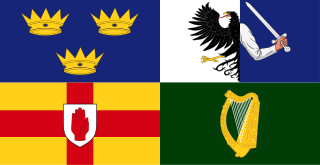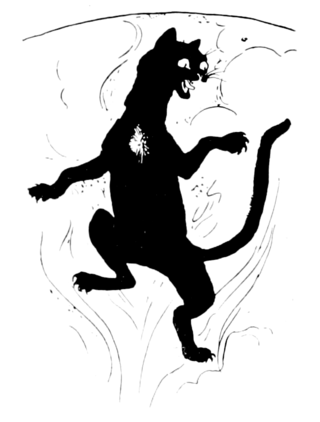
Aos sí is the Irish name for a supernatural race in Celtic mythology – daoine sìth in Scottish Gaelic – comparable to fairies or elves. They are said to descend from the Tuatha Dé Danann, meaning the 'People of Danu', depending on the Abrahamic or pagan tradition.

A leprechaun is a diminutive supernatural being in Irish folklore, classed by some as a type of solitary fairy. They are usually depicted as little bearded men, wearing a coat and hat, who partake in mischief. In later times, they have been depicted as shoe-makers who have a hidden pot of gold at the end of the rainbow.

The púca, pucapwca, pooka, phouka, puck is a creature of Celtic, English, and Channel Islands folklore. Considered to be bringers both of good and bad fortune, they could help or hinder rural and marine communities. Púcaí can have dark or white fur or hair. The creatures were said to be shape-changers that could take the appearance of horses, goats, cats, dogs, and hares. They may also take a human form, which includes various animal features, such as ears or a tail.
Finvarra, also called Finvara, Finn Bheara, Finbeara or Fionnbharr, is the king of the Daoine Sidhe of western Ireland in Irish folklore. In some legends, he is also the ruler of the dead. Finvarra is a benevolent figure, associated with horses, who ensures good harvests and rewards mortals with riches.

Irish folklore refers to the folktales, balladry, music, dance and mythology of Ireland. It is the study and appreciation of how people lived.

Tell Balgeary, Balgury Is Dead is an EP released in 2003 by Ted Leo and the Pharmacists, although it consists mostly of Ted Leo solo work. The title track comes from the band's previous album, Hearts of Oak, as is "The High Party". "Bleeding Powers" and "Loyal to My Sorrowful Country" are given full band treatment on 2004's Shake the Sheets and 2005's Sharkbite Sessions, respectively.
Carbonel is a children's book series by Barbara Sleigh, first published by Puffin Books from 1955 to 1978. Also published in the US by Bobbs-Merrill from 1955. It has three novels, first Carbonel: the King of the Cats and two sequels, The Kingdom of Carbonel and Carbonel and Calidor: Being the Further Adventures of a Royal Cat, and was based on the old British folk tale "The King of the Cats". The first edition of Carbonel was illustrated by V. H. Drummond, that of Kingdom by D. M. Leonard, and that of Carbonel and Calidor by Charles Front. Carbonel was named a Book of the Month by Young Elizabethan magazine, as a "most sensible, it-could-easily-have-happened fairy story".

The cat-sìth, in Irish cat sí, is a fairy creature from Celtic mythology, said to resemble a large black cat with a white spot on its chest. Legend has it that the spectral cat haunts the Scottish Highlands. The legends surrounding this creature are more common in Scottish folklore, but a few occur in Irish. Some common folklore suggested that the cat-sìth was not a fairy, but a witch that could transform into a cat nine times.
Katharine Mary Briggs was a British folklorist and writer, who wrote The Anatomy of Puck, the four-volume A Dictionary of British Folk-Tales in the English Language, and various other books on fairies and folklore. From 1969 to 1972, she was president of the Folklore Society, which established an award in her name to commemorate her life and work.

Folklore of the Low Countries, often just referred to as Dutch folklore, includes the epics, legends, fairy tales and oral traditions of the people of Belgium, Netherlands and Luxembourg. Traditionally this folklore is written or spoken in Dutch or in one of the regional languages of these countries.
French folklore encompasses the fables, folklore, fairy tales and legends of the French people.
Paul Galdone was an illustrator and writer known best for children's picture books.

Cornish mythology is the folk tradition and mythology of the Cornish people. It consists partly of folk traditions developed in Cornwall and partly of traditions developed by Britons elsewhere before the end of the first millennium, often shared with those of the Breton and Welsh peoples. Some of this contains remnants of the mythology of pre-Christian Britain.

Venusberg is a motif of European folklore rendered in various legends and epics since the Late Middle Ages. It is a variant of the folktale topos of "a mortal man seduced by the fairy queen visits the otherworld". In German folklore of the 16th century, the narrative becomes associated with the minnesinger Tannhäuser who becomes obsessed with worshipping the goddess Venus.
Punjabi folklore, more particularly its folksongs, are a core part of the Punjabi culture. Other important components of Punjabi folklore are farces, anecdotes, idioms, folktales, and sayings.

Deutsche Sagen is a publication by the Brothers Grimm, appearing in two volumes in 1816 and 1818. The collection includes 579 short summaries of German folk tales and legends.
Barbara Grace de Riemer Sleigh (1906–1982) was an English children's writer and broadcaster. She is remembered most for her Carbonel series about a king of cats.
Tromdámh Guaire is an Irish piece of prose satire about the relationship between the patron and poet and the abuse of privilege. Although the text itself is difficult to date, it is believed to have been composed no earlier than 1300. The only surviving copy of this text is found in the manuscript Leabhar Mhic Cárthaigh Riabhaigh or the Book of Lismore which itself dates to the fifteenth century. The story is set in seventh-century Ireland and is a literary showcase and parody of the practice of satire that was common among professional poets at the time. Tromdámh Guaire takes on a humorous look at the Bardic Order which a twelfth-century audience would have been aware of in order to "fully appreciate the biting sarcasm and satire contained in the narrative". This retrospective view does not give us an insight into seventh century Ireland, rather the twelfth-century perceptions of seventh century Ireland.









